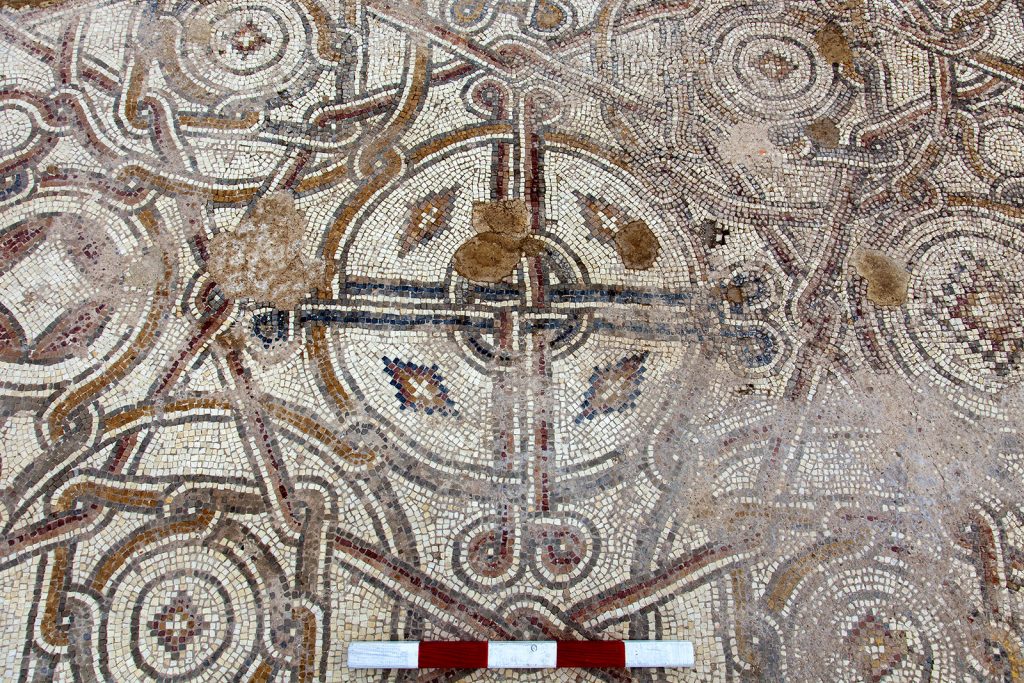 Tell es-Samak (Shikmona/Porphyreon) is an archaeological site located on the shores of the city of Haifa. The remains of a first settlement here were exposed on a small archaeological tel that meets at the seashore. The lower layers of the tel are of the Late Bronze Age (16th century BCE) and the upper ones belong to the Byzantine period (5th-6th centuries CE). The settlement flourished during the Roman period and the settlement, spread out beyond the borderlines of the small tel.
Tell es-Samak (Shikmona/Porphyreon) is an archaeological site located on the shores of the city of Haifa. The remains of a first settlement here were exposed on a small archaeological tel that meets at the seashore. The lower layers of the tel are of the Late Bronze Age (16th century BCE) and the upper ones belong to the Byzantine period (5th-6th centuries CE). The settlement flourished during the Roman period and the settlement, spread out beyond the borderlines of the small tel.
In 2010 the Shikmona Archaeological Project was launched under the direction of Dr. Michael Eisenberg and funded by the Hecht Foundation. Excavation on the tel under the direction of Dr. Shay Bar were conducted with the aim of studying the stratification of the tel and creating a precise chronological framework.

There is no identification for the site in the pre-Classical periods. Though the site is identified with the Jewish Shikmona, the latest research points that it should be identified as the Christian village/town of Porphyreon (south).
In 2021 a special edition of Michmanim (29) was dedicated to the site: M. Eisenberg and S. Bar (eds), Tell es-Samak (Shikmona/Porphyreon) on the Haifa Coast.
J. Elgavish conducted the main excavations at the site for 17 seasons, (1963–1979) exposing the strata from the Hellenistic, Roman and Byzantine periods. The Byzantine-period complexes were also excavated by other scholars, before Elgavish’s excavations and particularly after them. The recent excavations at the tell by S. Bar (2010–2012), and in the area of the town to the south by Eisenberg were carried out in the framework of the University of Haifa expedition. The renewed excavations unearthed mainly complexes from the Late Roman to the Byzantine periods and an attempt was made to integrate Elgavish’s conclusions and excavation results in an updated picture of the settlement at Tell es-Samak during these periods. Analysis of the historiographic evidence, historical maps, integration of the archaeological data, the well-developedpurple dye industry at the site, and finally, the magnitude of its Christian settlement during the Byzantine period, all reinforce the hypothesis that what we have here is the Christian town of Porphyreon (South) and not Jewish Shikmona.
The town reached its zenith during the Byzantine period, when it covered an area of approximately 80 dunams. Porphyreon was abandoned at the end of the 6th–early 7th centuries CE, apparently before the Persian conquest.

The Southern Church at Tell es-Samak (Porphyreon)
The Southern Church is located 130 m south of Tel Shikmona, on the shores of modern Haifa, Israel. J. Elgavish, who conducted large-scale excavations in Shikmona for 17 seasons (1963-1979), excavated large sections of the church, although he did not recognize it is a church, and called the area “a large monastery.” Renewed excavations at the site, directed by M. Eisenberg from 2010 to 2013, unearthed the church complex. The church is basilical in plan; a nave flanked by two aisles on the south and north and an exterior single central apse to the east. To the west are the remains of an atrium. Most of the walls were dismantled down to their foundations but enough mosaic carpets and structural elements remained to reconstruct most of it, including some of the interior design. The full length of the church is 39 m., its width is 14 m and it total area is approximately 500 m2. The church was fully covered by mosaic floors of which mainly those in the aisles
and on the bema survived.
The church was built at the end of the 4th–early 5th centuries CE above a 4th-century CE industrial pool complex. During the first half of the 5th century it was renovated, and it was destroyed around the mid-5th century CE.

לחופה של חיפה, סמוך לשכונת עין הים וצמוד למכון הלאומי לאוקיינוגרפיה נמצא תל קטן מידות המוכר כבר מאות שנים בשמו הערבי תל א-סמכ (‘תל הדגים’). בהיסטוריה המודרנית של תושבי חיפה ואף במרבית המחקרים זוהו התל והיישוב שהתפתח לצידו כתל שקמונה. עיקר המחקר הארכיאולוגי בתל וסביבתו נערכו במהלך 17 עונות חפירה שקיים באתר יוסף אלגביש בשנים 1963–1979, מטעם אגף המוזיאונים של עיריית חיפה. נחשפו חלקים גדולים מן התל וכן שטחים נרחבים מן היישוב שממזרח ומדרום לתל. חפירותיו של אלגביש זכו לפרסום מצומצם ביותר, וכך אחד מאתרי המפתח לאורך רצועת החוף של ישראל נותר רק עם מעט מידע למחקר הארכיאולוגי המודרני. שלוש חפירות הצלה מרכזיות נערכו בשנים 1998–2006 בשטחים שממזרח לתל, החל במסילות הרכבת וכלה במורדות המערביים של הכרמל, הנושקים לכביש 4 חיפה–תל אביב (טורגה עד 1998–1999; קלטר 1999–2000; והירשפלד 2006). ממצאי החפירות הללו תרמו להבנת שוליו המזרחיים של היישוב הביזנטי, אך התל והעיירה סביבו נותרו בלתי ידועים עד חידוש החפירות והמחקר באתר בשנת 2010 בידי משלחת מטעם אוניברסיטת חיפה. במסגרת המחקר המחודש בתל יצא לאור בשנת 2021 גיליון מיוחד של כתב העת מכמנים ובו ריכוז של 11 מאמרים סביב השרידים הארכיאולוגיים בתל: מ’ איזנברג וש’ בר (עורכים), תל א־סמכ (שקמונה/פורפיריון) לחופה של חיפה.



